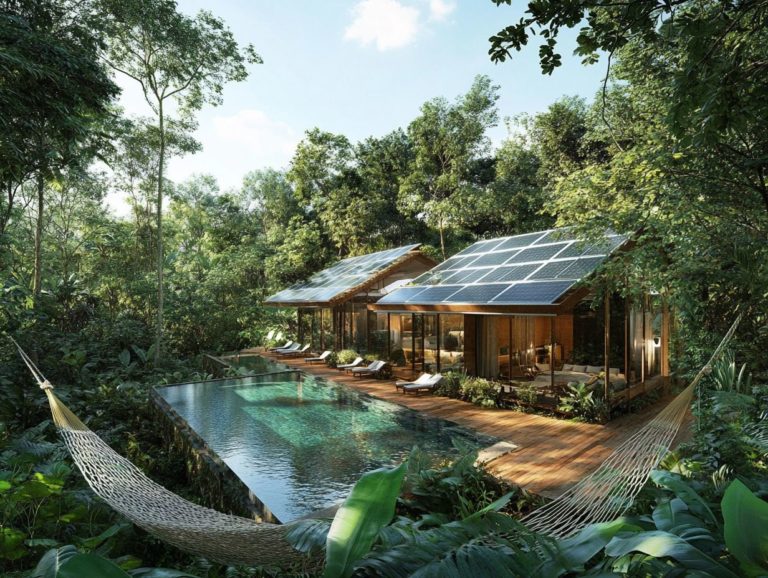How to Evaluate Eco-Friendly Hotels
Understanding the light requirements for plants is crucial if you’re aiming to cultivate a flourishing garden, whether indoors or outdoors. This is especially true when considering various grow light options.
Get ready to discover the factors that influence plant growth and their unique light needs. We’ll explore the importance of light quality and intensity, distinguish between natural and artificial light, and examine the significance of full-spectrum versus specific-type lighting. You ll also find practical tips for fine-tuning light conditions for both indoor and outdoor plants.
It highlights mistakes to avoid to help your plants get the right amount of light. Dive in to uncover the secrets to achieving healthy, vibrant greenery with effective light strategies for your houseplants!
Contents
- Key Takeaways:
- Understanding Light Requirements for Plants
- Types of Light for Different Plant Types
- Adjusting Light for Indoor Plants
- Adjusting Light for Outdoor Plants
- Common Mistakes in Adjusting Light for Plants
- Frequently Asked Questions
- What are the different types of plants that require adjustment of light?
- How do I know if my plant needs more or less light?
- What are some ways to adjust light for my plants?
- Can I use the same light for all types of plants?
- How long should I leave the lights on for my plants?
- What Are Some Common Mistakes to Avoid When Adjusting Light for Plants?
Key Takeaways:

- Different plants have different light needs based on their growth stage and natural habitat, including the type of light they thrive under.
- For indoor plants, use full-spectrum artificial light and place them near windows to maximize light exposure.
- Outdoor plants may require different lighting adjustments depending on their location, the time of day, and weather conditions.
Understanding Light Requirements for Plants
Understanding the light requirements for your plants is essential if you’re diving into indoor gardening. Adequate light exposure directly affects plant growth and overall health.
Each type of plant has its own unique needs for light intensity and type of light, both of which are crucial for the way plants make their food using light. By analyzing the type of light and using effective gardening methods, you can optimize energy efficiency and create an environment where your houseplants like succulents, flowering plants, and cacti can truly flourish. It’s also important to consider adjusting light for seasonal changes to ensure their continued health.
Factors Affecting Plant Growth and Light Needs
Several factors significantly influence your houseplants’ growth and light requirements, including humidity levels and watering schedules. Both should be tailored for the specific plants you re nurturing.
Understanding how these elements interact is vital for achieving optimal growth and health. For instance, increased humidity can improve a plant’s ability to absorb water, but if there s low light, it could lead to fungal issues. A good watering schedule combined with plenty of bright, indirect sunlight encourages vigorous growth and lush foliage.
Temperature variations also play a crucial role; some plants prefer warmer environments, while others thrive in cooler conditions. By managing these factors expertly, you can create an environment that supports robust plant development.
Types of Light for Different Plant Types
You have a variety of light options available for different types of plants, from the natural brilliance of sunlight to artificial sources like LED lights, fluorescent bulbs, and incandescent fixtures.
Each lighting type has its unique qualities, including differences in type of light and intensity, all of which can significantly impact plant health and growth rates.
By grasping these differences, you can optimize the lighting setup for your indoor garden, ensuring that both your flowering plants and succulents thrive under the right conditions.
Start optimizing your plant lighting today and watch your garden thrive!
Natural vs Artificial Light

When you compare natural light to artificial light, it s crucial to recognize that natural light is the gold standard for plant growth. It serves as the ideal sunlight substitute for houseplants that flourish under direct exposure.
Natural light delivers a spectrum of wavelengths essential for photosynthesis, promoting vibrant growth and encouraging beautiful blooms. While artificial light, such as LED grow lights, can supplement or mimic sunlight, it often falls short in providing the necessary spectrum and intensity for optimal plant health.
Each type of light plays a significant role in how plants respond. Natural light typically allows for longer exposure durations, which translates to better overall vigor.
Artificial options, such as LED grow lights, can create tailored light conditions and offer control over intensity, enabling successful cultivation even in less-than-ideal environments. By understanding these dynamics, you can strike the right balance for exceptional plant care.
Full Spectrum vs Specific Spectrum
Choosing between full spectrum and specific spectrum lights can significantly impact chlorophyll production and overall plant health. Full spectrum lights deliver a balanced range of wavelengths that closely mimic natural sunlight, providing your plants with a complete light experience.
Specific spectrum lights are designed to emit targeted wavelengths that cater to particular growth stages, allowing for more precise outcomes. For example, during the germination phase, your plants thrive on specific blue wavelengths that promote robust root development and healthy seedlings. As your plants transition to the flowering stage, they will thrive with red wavelengths, which encourage blooming and fruiting.
Grasping these nuances in light quality equips you to optimize your indoor or greenhouse setups. For more information, explore the best light sources for indoor plants, ensuring your plants receive the most suitable light spectrum at each essential growth stage.
Adjusting Light for Indoor Plants
To get the best from your indoor plants, you need to carefully adjust their light exposure. This involves optimizing light placement and establishing an effective grow light setup. Each plant should receive the appropriate light cycling and duration necessary for their optimal growth.
Paying attention to these details can turn your indoor garden into a thriving oasis.
Tips for Providing Adequate Light
To ensure your indoor plants thrive, it’s wise to invest in light meters, which are tools that measure light intensity and quality. This will guide you in selecting various grow light brands that provide effective solutions for your indoor gardening venture.
These meters are invaluable for determining if your plants are receiving the right spectrum and amount of light necessary for optimal growth, which is essential for photosynthesis. Wondering which brands to trust? Look for those known for their energy efficiency and durability; this choice can significantly enhance your plant care routine.
To take your lighting setup to the next level, consider incorporating smart timers and programmable systems that adjust lighting schedules based on your plants’ specific needs. Regularly assessing the light quality from these sources ensures that it’s not only bright enough but also closely mimics natural sunlight. For more detailed guidance, check out our resource on understanding indoor plant light needs, creating a nurturing indoor environment for your plants to flourish.
Adjusting Light for Outdoor Plants

Adjusting light for your outdoor plants demands a thoughtful approach to their natural light exposure. By strategically placing your plants, you can maximize sunlight and create the ideal environment for them to flourish in their growing conditions.
Factors to Consider for Outdoor Lighting
When planning outdoor lighting for your plants, it s crucial to think about how seasonal changes affect light management and strategies for maintaining plant health year-round.
Factors such as the sun s angle, daylight duration, and the intensity of natural light significantly influence how your plants absorb light. For instance, in winter, shorter days and lower sun angles can lead to inadequate light exposure, which makes supplemental artificial lighting essential.
To optimize light for your plants, consider using LED grow lights, which mimic natural sunlight and are easily adjustable. Setting up reflective surfaces around your plants can also maximize available light, ensuring that shaded spots receive the illumination they need.
Get ready to create the perfect environment that promotes healthy growth, no matter the season!
Common Mistakes in Adjusting Light for Plants
When adjusting light for your plants, be aware of common mistakes like overexposure and underexposure. Both can significantly impact the health and growth of your plants.
Understanding proper light cycling and establishing the right watering schedule are key for a thriving indoor garden.
Avoiding Overexposure or Underexposure
To avoid the pitfalls of overexposure or underexposure, grasp the light requirements of various plant types and implement effective ways to manage light tailored to their needs.
By assessing the unique light conditions that each species thrives in, you can adapt your setups indoors and outdoors, ensuring the right light management strategies are in place.
Utilizing tools like light meters allows for precise measurements, helping you pinpoint areas that may need more sunlight or those that could benefit from a little shade.
Employing adjustable grow lights can cater to plants with diverse light preferences, ensuring they receive just the right amount of exposure.
Regularly rotating your plants prevents any one side from soaking up too much glare, promoting even growth all around, which is essential for their overall development.
Understanding these essential factors can significantly enhance your plants’ health, leading to vibrant foliage and lush blooms that will truly stand out in your indoor gardening efforts.
Frequently Asked Questions

What are the different types of plants that require adjustment of light?
Many plants require specific light levels, such as succulents, cacti, herbs, flowering plants, indoor plants, and tropical plants, each with unique light needs.
How do I know if my plant needs more or less light?
You can tell if your plant needs more or less light by observing its growth and color. If it’s tall and spindly, it may need more light. Yellow or brown leaves may indicate too much light exposure, signaling a need for light management.
What are some ways to adjust light for my plants?
Adjust light for your plants by changing their position near a window or using artificial lights like high-intensity discharge grow bulbs, LED lights, or fluorescent lights to enhance photosynthesis. Shades or curtains can also help control the amount of natural light your plants receive.
Can I use the same light for all types of plants?
No, different plants have different light needs, so research and understand the specific requirements of each plant. Some may need more light, while others may need less.
How long should I leave the lights on for my plants?
The time your plants need light depends on their type and specific light requirements, including full spectrum and adjustable spectrum lights for optimal exposure. Generally, most plants need 12-16 hours of light daily, but it’s best to research each plant’s needs for optimal growth.
Ready to give your plants the best care? Dive deeper into plant care and watch them thrive!
What Are Some Common Mistakes to Avoid When Adjusting Light for Plants?
Are you making these common mistakes when adjusting light for your plants? Not giving them enough light or using traditional light bulbs instead of energy-efficient LED lights can hamper growth.
Avoid leaving the lights on too long or too short. Big shifts in how bright the light is can shock your plants and harm their health.






